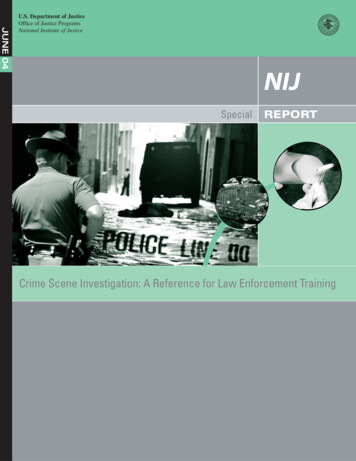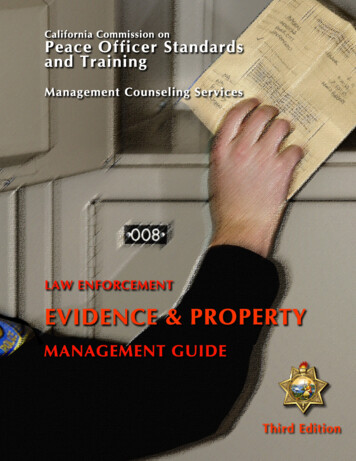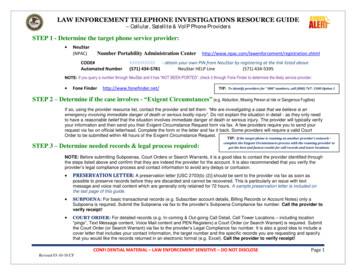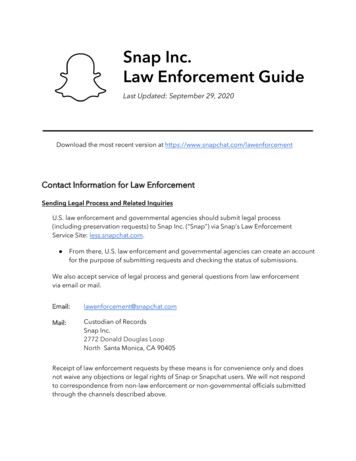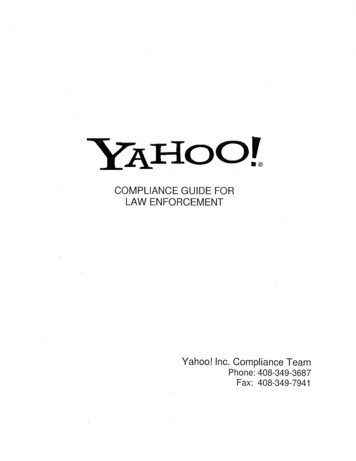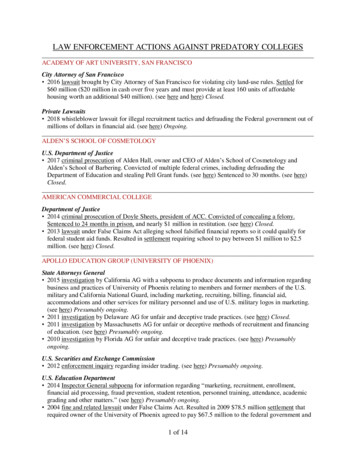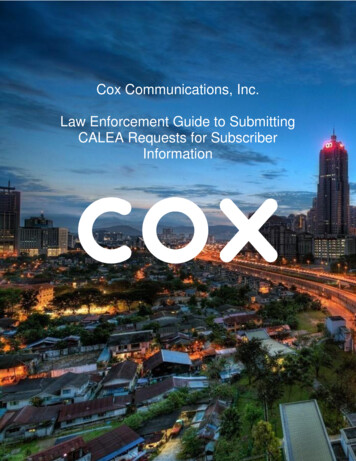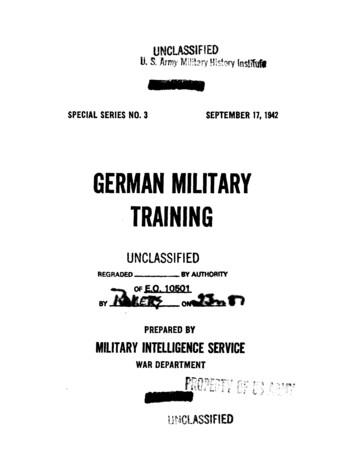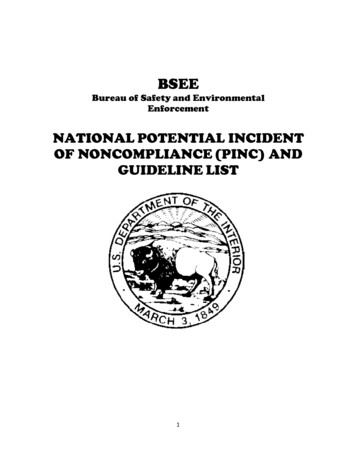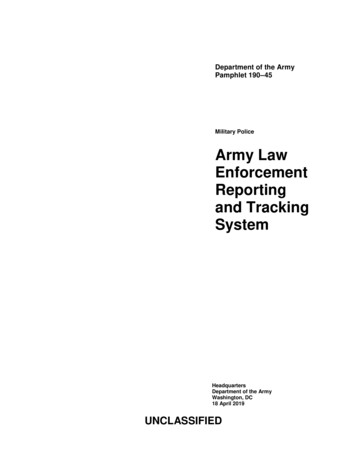
Transcription
Department of the ArmyPamphlet 190–45Military PoliceArmy LawEnforcementReportingand TrackingSystemHeadquartersDepartment of the ArmyWashington, DC18 April 2019UNCLASSIFIED
SUMMARYDA PAM 190 – 45Army Law Enforcement Reporting and Tracking SystemThis new publication, dated 18 April 2019-oProvides sample reports (chap 2 and chap 5).oProvides an overview of the case review process (chap 5).oProvides guidance about roles in reporting and tracking cases (throughout).
HeadquartersDepartment of the ArmyWashington, DC18 April 2019Pamphlet 190–45Military PoliceArmy Law Enforcement Reporting and Tracking SystemApplicability. This pamphlet applies tothe Regular Army, the Army NationalGuard/Army National Guard of the UnitedStates, and the U.S. Army Reserve, unlessotherwise stated. It also applies to Department of the Army Civilian police, criminalinvestigators, and security guard activities.This pamphlet applies during partial andfull mobilization.Proponent and exception authority.The proponent for this pamphlet is theProvost Marshal General. The proponenthas the authority to approve exceptions orwaivers to this pamphlet that are consistentwith controlling law and regulations. TheHistory. This publication is a new De- proponent may delegate this approval aupartment of the Army pamphlet.thority, in writing, to a division chief withinSummary. This pamphlet provides a the proponent agency or its direct reportinggeneral operational guide for roles created unit or field operating agency, in the gradewithin the DA Form 190 –45– SG (Army of colonel or the civilian equivalent. ActivLaw Enforcement Reporting and Tracking ities may request a waiver to this pamphletSystem (ALERTS)), to support law en- by providing justification that includes aforcement reporting functions.full analysis of the expected benefits andmust include formal review by the activity’s senior legal officer. All waiver requests will be endorsed by the commanderor senior leader of the requesting activityand forwarded through their higher headquarters to the policy proponent. Refer toAR 25 – 30 for specific guidance.Suggested improvements. Users areinvited to send comments and suggestedimprovements on DA Form 2028 (Recommended Changes to Publications and BlankForms) directly to the Provost MarshalGeneral (DAPM – MPO– LE), 2800 ArmyPentagon, Washington, DC 20310 – 2800.Distribution. This pamphlet is availablein electronic media only and is intended forthe Regular Army, the Army NationalGuard/Army National Guard of the UnitedStates, and the U.S. Army Reserve.Contents (Listed by paragraph and page number)Chapter 1Overview Army Law Enforcement Reporting and Tracking System, page 1Section IIntroduction, page 1Purpose 1– 1, page 1References 1– 2, page 1Explanation of abbreviations and terms 1 – 3, page 1Section IIInitiating a Case in Army Law Enforcement Reporting and Tracking System, page 1Receipt of a criminal complaint 1 – 4, page 1Subject/suspect 1– 5, page 2Victims 1– 6, page 3Types of offenses 1 – 7, page 4Case numbers 1 – 8, page 4U.S. Army Crime Records Center numbers 1 – 9, page 5Initiating the blotter 1 – 10, page 5Initiating a journal 1 – 11, page 6DA PAM 190–45 18 April 2019UNCLASSIFIEDi
Contents—ContinuedChapter 2Investigative Reports, page 6Section IThe Law Enforcement Report, page 6Preparing the law enforcement report 2 – 1, page 1Format of the law enforcement report 2 – 2, page 7Initial law enforcement report 2 – 3, page 11Status law enforcement report 2 – 4, page 11Final law enforcement report 2 – 5, page 13Initial/final law enforcement report 2– 6, page 15Interim law enforcement report 2 – 7, page 15Supplemental law enforcement report 2 – 8, page 15Corrected law enforcement report 2 – 9, page 16Referred law enforcement report 2 – 10, page 16Collateral law enforcement report 2 – 11, page 16Joint law enforcement report 2 – 12, page 16Section IISerious Incident Reports, page 16Reporting criteria 2 – 13, page 16Preparation and dispatch 2 – 14, page 16Absent without leave, and deserter situations 2 – 15, page 17Protective orders 2 – 16, page 17Case activity summary 2 – 17, page 17Chapter 3Criminal Offense Codes, page 19Reporting offenses 3 – 1, page 19Primary offense code 3– 2, page 19Detailed offense code 3 – 3, page 19Special considerations 3 – 4, page 20Chapter 4Commander’s Report of Disciplinary or Administrative Action, page 20Background 4 – 1, page 20Commander’s responsibilities 4 – 2, page 20Completing a Department of the Army Form 4833 in the tracking system 4 – 3, page 21Chapter 5Case Review Process, page 21Law enforcement official starts review process 5 – 1, page 21Supervisors influence review process 5 – 2, page 21AppendixesA. References, page 50B. Offense Codes for Army Investigations, page 53Table ListTable B– 1: Offense code list, page 53Figure ListFigure 1 – 1: The case flow for DA Form 190– 45 – SG, also known as ALERTS, page 2Figure 1 – 2: Example of case number format, page 5iiDA PAM 190–45 8 April 2019
Contents—ContinuedFigure 1 – 3: Example of a Crime Records Center number format, page 5Figure 2 – 1: Example of an offense listing, page 7Figure 2 – 2: Example of date, time, and location of occurrences, page 7Figure 2– 3: Example of a report summary, page 9Figure 2 – 4: Sample of unique circumstances with information, page 9Figure 2 – 5: Sample of unique circumstances without information, page 10Figure 2 – 6: Sample of unique circumstances with partial information, page 10Figure 2 – 7: Sample of a no-media-interest annotation, page 10Figure 2 – 8: This sample documents interest by regional media, page 11Figure 2– 9: Sample report summary for a status law enforcement report, page 12Figure 2– 10: Sample of exhibits for a final law enforcement report, page 14Figure 2 – 11: Status statements for various reports, page 15Figure 2 – 12: Sample of case activity summary, page 18Figure 5 – 1: Sample of an initial law enforcement report, page 22Figure 5–2: Sample of a 1st status law enforcement report, page 24Figure 5 – 3: Sample of a final law enforcement report, page 26Figure 5 – 4: Sample of an initial/final law enforcement report (drug offense), page 30Figure 5 – 5: Sample of a serious incident report (category 2) initial/final law enforcement report, page 33Figure 5 – 6: Sample of a serious incident report (category 2) final supplemental law enforcement report, page 35Figure 5 – 7: Sample of a serious incident report (category 1) initial law enforcement report, page 37Figure 5 – 8: Sample of a serious incident report (category 1) 1st status law enforcement report, page 39Figure 5 – 9: Sample of a serious incident report (category 1) final law enforcement report, page 41Figure 5 – 10: Sample of a serious incident report (category 1) 1st supplemental law enforcement report, page 44Figure 5 – 11: Sample of a serious incident report (category 1) 2nd final supplemental law enforcement report, page 47GlossaryDA PAM 190–45 18 April 2019iii
Chapter 1Overview Army Law Enforcement Reporting and Tracking SystemSection IIntroduction1– 1. PurposeThis pamphlet provides procedural guidance for the preparation and reporting of law enforcement reports (LERs), andserious incident reports (SIRs), using DA Form 190 – 45 – SG (Army Law Enforcement Reporting and Tracking System(ALERTS)). This pamphlet standardizes the use of this system as the automated reporting system for military law enforcement reporting throughout the Army, providing commanders, Headquarters, Department of the Army (HQDA), and theDepartment of Defense (DOD) a record of LERs and services. Policy pertaining to each of these reports is contained inAR 190 – 45.1– 2. ReferencesSee appendix A.1– 3. Explanation of abbreviations and termsSee the glossary.Section IIInitiating a Case in Army Law Enforcement Reporting and Tracking System1– 4. Receipt of a criminal complainta. Criminal complaint. A criminal complaint is defined as an allegation of incidents with a criminal nexus and doesnot include acts of nature, special events, special missions, accidental damage incidents, or health and welfare incidents,unless they result in a criminal offense. AR 195– 2 defines which organization (such as the Criminal Investigation Division(CID), installation law enforcement, or a command unit) fulfills roles to investigate a suspected criminal offense when theArmy has an interest.b. Installation law enforcement, for offenses not under the Criminal Investigation Division’s purview. When an installation law enforcement supervisor receives an initial complaint of an offense, a patrol is assigned the case or investigation.A case is begun as an LER (see para 2– 1), and all useful and mandatory information is entered into DA Form 190– 45– SG,also known as ALERTS.(1) If no further investigative activity is required by the patrol, a combined initial-final LER is started, and the report issent to a designated approver of case reports. The approver is then prompted to consider if the information will be sent tothe military police (MP) blotter in the raw data file (RDF). The approver may determine that the offense code of the LERis U.S. Army Crime Records Center (CRC) reportable and then adds the CRC number, if applicable.(2) If further police or investigative activity is required by the patrol, military police investigation (MPI) unit, or trafficaccident investigation (TAI) unit, an initial report is started, and then submitted to the designated approver of case reports.The designated approver may decide to send the information to the blotter before dispatching the initial report. Dependingon the offense, the designated approver may transfer the LER to an MPI unit, TAI unit, or to CID. An initial LER requirespublication of a final LER, unless it is a combined initial-final report.(3) When a law enforcement element receives information about an alleged criminal incident that may be of Armyinterest, a case is initiated using ALERTS. A case number is automatically assigned.c. Installation law enforcement, for offenses under the Criminal Investigation Division’s purview. When the installation law enforcement officer receives a complaint and determines the offense is within the CID investigative purview,there are two possible courses of action. The installation law enforcement officer can initiate and dispatch the initial LER,using ALERTS, and then refer the matter to CID. Or CID can initiate the investigation, in ALERTS, and follow throughto initiate and dispatch the initial report.(1) The law enforcement officer or CID special agent provides details and actions taken, throughout the course of theirinvestigation, within the case activity summary (CAS) tab of DA Form 190 – 45 – SG, also known as ALERTS. For example,full identities of all known complainants, victims, witnesses, offenders, and so forth should be included. The time it takesto gather such data should also be reported.DA PAM 190–45 18 April 20191
(2) Accuracy is essential in reporting for LERs. Users who approve LERs, such as designated approvers and CID supervisors, should review the report in ALERTS, and direct any corrections before approval of the LER, ensuring mandatorydata fields are accurate and complete.Figure 1–1. The case flow for DA Form 190–45– SG, also known as ALERTS1– 5. Subject/suspecta. A subject/suspect is a person, corporation, or other legal entity about whom credible information exists that wouldcause a trained investigator or police officer to presume that the person committed a criminal offense in accordance withDODI 5505.7. See AR 190 – 45 for titling and indexing policy.b. As with other civilian offenders, titling juveniles as subject/suspects in a LER is appropriate only if their activitiesare a violation of an applicable Federal, State, or foreign statute. The juvenile offenders biographical and sponsor information will be followed by the automated notation in ALERTS: "JUVENILE - This record may be released only as authorized by AR 195 – 2, and AR 190 – 45. In overseas areas, if there is no violation of a U.S. statute with extraterritorialapplication and the host country law establishes a threshold age for criminality, those subjects below the requisite age arenot listed in the subject/suspect block, but are only identified in the investigative summary of the LER.”2DA PAM 190–45 18 April 2019
c. A corporation is criminally liable for the acts of its agents or employees, if the agent or employee commits a crimewithin the scope of his employment and with intent to benefit the corporation. Therefore, in that type of report, the individual and corporation will be titled as subject/suspects.d. The LER is a “case-based” report, meaning an incident(s) is documented within a particular case, and the incident(s)in turn contains an offense(s). Since the Defense Incident-Based Reporting System (DIBRS) is incident-based and notcase-based, a “subject/suspect” entity must be linked to each incident to accurately report incidents in DIBRS.(1) The entry “unknown” will be used as the subject/suspect entity in a LER:(a) When a subject/suspect is not identified, or(b) Where a subject/suspect is identified but no credible information exists to title the subject/suspect. In the lattersituation, the subject/suspect will be identified in the report summary. If there is more than one unknown subject/suspect,“unknown” will be listed consistent with the number of subject/suspects reported. For example, if a victim reports beingassaulted by two unknown subject/suspects and then raped by a third, the LER will reflect "unknown” for subject/suspects1, 2, and 3. This procedure allows the linking of subject/suspects to the specific offenses. Biographical data pertaining to“unknown” subject/suspects will be recorded as it becomes known. As “unknown” subject/suspects become identified, the“unknown” will be overwritten with the information pertaining to the identified subject/suspect. If an LER initially containsan “unknown” subject/suspect, and all offense(s) pertaining to the subject/suspect are cleared in the investigation process,the “unknown” will be changed to “none.”(2) The entry “none” will be used as the subject/suspect entity in undetermined deaths, suicides, and accidental ornatural deaths when no other offenses are involved. In those cases the deceased person will be entered as a victim.(3) The entry “none” will be used as the subject/suspect entity in cases determined to be cleared through the investigation process prior to the dispatch of the initial report. If, based upon the totality of the preliminary portion of the investigation, the “victim” was intentionally deceptive, then the victim may be added as subject/suspect 2 for filing a false report,false swearing, and so forth; however, “none” will remain as subject/suspect 1.(4) The entry “none” will be used as the subject/suspect entity in a status LER, final LER, and supplemental LER, whenall offenses pertaining to that entity are determined to be unfounded. However, a previously listed “unknown” subject/suspect entity will remain as “unknown” if any offense is determined to be founded, or when there is insufficient evidence.When an actual entity (person) other than "unknown" is listed in the subject/suspect block, and all offenses are determinedto be unfounded, that entity will remain listed in the subject/suspect block.1– 6. Victimsa. The victim of a crime against persons (for example, murder, robbery, assault, or rape) is the person who suffered theinjury or who was put in danger or fear by the criminal act.b. The victim for all offenses involving sex crimes between consenting adults, except adultery, is the Government (forexample, Government [Indecent Acts]). For further guidance regarding adult private consensual sexual misconduct referto DODI 5505.08.c. In cases of adultery when a married Servicemember is a subject/suspect, his or her spouse will be listed as a victim.However, if the only married subject/suspect is a nonmilitary member, then the Government will be listed as the victim.d. In cases of bigamy, the victims will be the alleged spouses, lawful and unlawful, and the State where the fraudulentmarriage occurred. In the event services were rendered by the Government to the unlawful spouse, the Government wouldbe added as a victim for the offenses of fraud and false official statements. In general, marriages that are legally performedand valid abroad are also legally valid in the United States. Inquiries regarding the validity of a marriage abroad should bedirected to the attorney general of the State in the United States where the parties to the marriage live.e. The victim of a crime against property (for example, larceny, damage to private property or housebreaking) is theowner of the property involved.(1) The owner of private property is the person, corporation, or other legal entity commonly viewed as having ownership, regardless of security interests (for example, liens, mortgages) held by others.(2) The owner of Government property is the U.S. Government. Further identification by agency, activity, or unit downto company, battery, or troop level may be made in parentheses, such as, U.S. Government, (A Company, 71st OrdnanceBattalion), Fort Example, FL. Individuals having personal responsibility for U.S. Government property entrusted to themfor their exclusive personal use will also be listed as a victim. (An example of exclusive use is a government laptop computer hand receipted for use while on temporary duty.)(3) The victims of housebreaking or burglary in U.S. Government quarters or barracks will be both the U.S. Governmentand the assigned occupant. In the case of privatized quarters, the company that owns the quarters (and not the U.S. Government) and the assigned occupant are the victims.f. For all offenses involving wrongful possession and/or distribution of controlled substances, the victim will be determined by the applicable statute cited. For example, the State of Texas would be the victim if the subject/suspect is titledDA PAM 190–45 18 April 20193
with an offense of the Texas Penal Code, and the U.S. Government would be the victim if the subject/suspect is titled withan offense of the Uniform Code of Military Justice (UCMJ) or U.S. Federal law. In cases pertaining to military personnelusing controlled substances on or off a military installation, the U.S. Government will be listed as the only victim (exceptin collateral or joint cases in which the state statutes should be listed).g. Juvenile victims will be listed by name and identifying information, followed by the automated ALERTS notation“JUVENILE - this record may be released only authorized by AR 195 – 2, Para 4–3f and AR 190 – 45, Para 2–1k." AR190 – 45 and AR 195 – 2 limit the distribution of LERs involving juvenile victims to persons authorized access to juvenileoffender records, those in normal distribution channels, and other law enforcement agencies when there are indications ofcriminal activity which may fall within the responsibility of that agency. Distribution of LERs involving juvenile victimswill be strictly limited to those with a need to know.h. An entity listed as a victim will not be deleted from the LER under any circumstances. If during the course of reporting the incident, it is determined the entity is not a victim of the offense, a status or final report will be generated unfoundingthe offense.i. In a case arising under the UCMJ, a victim has the right to refuse to disclose, and to prevent any other person fromdisclosing, a confidential communication made between the victim and a victim advocate, if such communication wasmade for the purpose of giving advice or supportive assistance to the victim. For specific details, refer to Rule 514, MilitaryRules of Evidence.j. Individuals identified as a victim should be provided a copy of the DD Form 2701 (Initial Information for Victimsand Witn
SG (Army Law Enforcement Reporting and Tracking System (ALERTS)). This pamphlet standardizes the use of t his system as the automated reporting system for military law enforce-ment reporting throughout the Army, providing commanders, Headquarters, Department of the Army (HQDA), and the D
